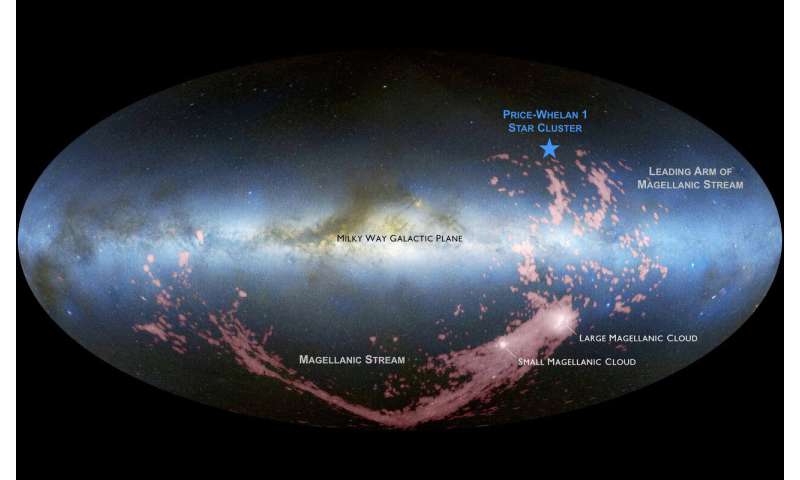
The outskirts of the Milky Way are home to the galaxy’s oldest stars. But astronomers have spotted something unexpected in this celestial retirement community: a flock of young stars.
More surprising still, spectral analysis suggests that the infantstarshave an extragalactic origin. The stars seemingly formed not from material from the Milky Way, but from two nearbydwarf galaxiesknown as the Magellanic Clouds. Thosegalaxiesare on a collision course with our own. The discovery suggests that a stream of gas extending from the galaxies is about half as far from crashing into the Milky Way as previously thought.
“This is a punycluster
The newfound stars could reveal new insights into the Milky Way’s history; they might, for example, tell if the Magellanic Clouds collided with our galaxy in the past.
Price-Whelan and his colleaguespresent their findingsJanuary 8 at the American Astronomical Society meeting in Honolulu. They previouslyreported the discoveryof Price-Whelan 1 on December 5 inThe Astrophysical Journaland
Identifying clusters of stars is tricky because our galaxy is chock-full of the radiant orbs. Some stars may appear to be close together in the sky but actually sit at drastically different distances from Earth. Other stars may temporarily neighbor one another but move on in opposite directions. Determining which stars are actually clustered together requires many precise measurements over time.
Price-Whelan started with the latest data collected by the Gaia spacecraft, which has measured and cataloged the distances and motions of 1.7 billion stars. He searched the Gaia dataset for very blue stars, which are rare in the universe, and identified clumps of stars moving alongside them. After cross-matching with and removing known clusters, one remained.
The newfound cluster is relatively young at million years old and is on the far outskirts of the Milky Way. “It’s really, really far away,” Price-Whelan says. “It’s further than any known young stars in the Milky Way, which are typically in the disk. So right away, I was like, ‘Holy smokes, what is this?’ ‘
The cluster inhabits a region near a river of gas, dubbed the Magellanic Stream, that forms the outmost edge of the Large and Small Magellanic Clouds and reaches toward the Milky Way. Gas in the stream does not contain much metal, unlike gases in the outer reaches of the Milky Way. David Nidever, assistant professor of physics at Montana State University in Bozeman, led an analysis of the metal content of the brightest stars in the cluster. Just like the Magellanic Stream, the stars contain meager levels of metal.
The researchers propose that the cluster formed as gas from the Magellanic Stream passed through the gases surrounding the Milky Way. This pass-through created adrag forcethat compressed the Magellanic Stream gas. This drag, along with tidal forces from the Milky Way’s gravitational tug, condensed the gas enough to trigger star formation. Over time, the stars zoomed ahead of the surrounding gas and joined the Milky Way.
The stars’ presence presents a unique opportunity. Gauging the distance of gas from Earth is tricky and imprecise, so astronomers weren’t sure how far the Magellanic Stream was from reaching the Milky Way. The distance of stars, on the other hand, is comparatively trivial. Using the current positions and movements of stars in the cluster, the researchers predict that the edge of the Magellanic Stream is (**************************************************************, 0 light-years away from the Milky Way. That’s roughly half the distance previously predicted.
“If the Magellanic Stream is closer, especially the leading arm closest to our galaxy, then it’s likely to be incorporated into the Milky Way sooner than the current model predicts,” Nidever says. “Eventually, that gas will turn into new stars in the Milky Way’s disk. Right now, our galaxy is using up gas faster than its being replenished. This extra gas coming in will help us replenish that reservoir and make sure that our galaxy continues to thrive and form new stars. “
The updated distance to the Magellanic Stream will improve models of where the Magellanic Clouds have been and where they’re going, Price-Whelan says. The improved numbers could even settle a debate over whether the Magellanic Clouds have crossed through the Milky Way before. Finding an answer to that question will help astronomers better understand the history and properties of our galaxy.
More information:Adrian M. Price-Whelan et al, Discovery of a Disrupting Open Cluster Far into the Milky Way Halo: A Recent Star Formation Event in the Leading Arm of the Magellanic Stream ?, (The Astrophysical Journal(). DOI: (**************************************************** / – ab4bdd David L. Nidever et al. Spectroscopy of the Young Stellar Association Price-Whelan 1: Origin in the Magellanic Leading Arm and Constraints on the Milky Way Hot Halo,Astrophysical Journal(. DOI: / – / ab (fc
Citation: The Milky Way’s impending galactic collision is already birthing new stars ((******************************************************, January 8) retrieved 8 January 2020 from https://phys.org/news/4357 – – milky-impending -galactic-collision-birthing.html
This document is subject to copyright. Apart from any fair dealing for the purpose of private study or research, no part may be reproduced without the written permission. The content is provided for information purposes only.
(Read More) ************************************************** (************************************************





GIPHY App Key not set. Please check settings